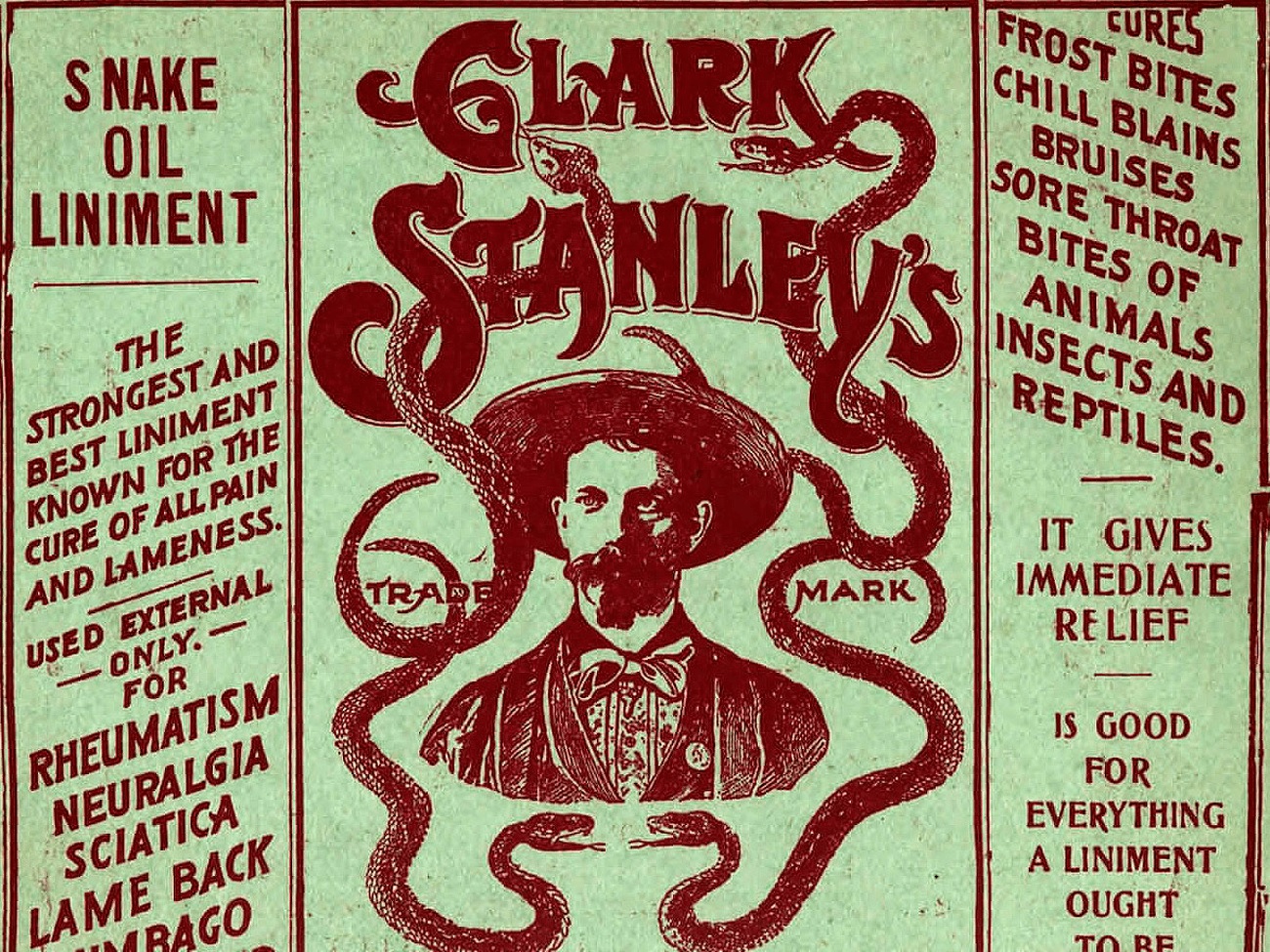
Snake oil was a term used to describe a fraudulent or ineffective cure-all remedy that was popular in the 19th century. The term originated from a practice used by Chinese laborers who used snake oil as a topical ointment to relieve joint pain and inflammation. However, in the United States, unscrupulous salesmen began to market their own versions of snake oil, claiming that it could cure a wide variety of ailments, including everything from headaches to cancer.
The original snake oil was made from the oil extracted from the Chinese water snake, which contains high levels of omega-3 fatty acids that can help reduce inflammation. However, most of the snake oil sold in the United States during the 19th century was made from a variety of other oils and ingredients, such as beef fat, turpentine, and camphor.



The term “snake oil” became synonymous with placebo, but in the same breath you’ll hear that a lot of 1800s snake oil contained opiates or coca leaf/cocaine or was almost pure ethanol. I’m pretty sure it was doing something!
In 1893, Clark Stanley made a giant spectacle by slicing open a live snake, dunking it in boiling water, skimming fat off the top, and pouring it into a bottle. Snake-oil sales made him a fortune. His snake oil bottles contained 0% snake oil – he actually used mineral oil, beef tallow, turpentine, and other things. It was found out that he falsely and fraudulently advertised it as a remedy for all pain and was fined about $500. Snake oil became synonymous with fraud around then. Many stageplays have incorporated the ‘Charismatic salesman trying to sell you this awful blend of junk while hopeful idiots are duped’ scene of snake oil salesmen and traveling doctors. The Music Man had a character focused on a scammer with Clark Stanley’s big showman style of convincing a crowd to buy in, and Iceman Commeth had some poignant lines sneering at his rival, calling him a snake-oil salesman “making suckers of the damned, telling them there’s nothing like snake oil for a bad burn.” In addition, the popularity of patent medicines soared dramatically in the late 19th century. These tonics were often advertised on the back pages of newspapers and promised to cure a variety of ailments, including chronic pain, headaches, women’s complaints, and kidney problems. All of these false “cures” became known as snake oil over time
All of those poor snakes were butchered for no reason
Chinese traditional medicine combines surprisingly clinically proven folk remedies with total bullshit
Folk medicine is decent at figuring out what works but terrible at figuring out why.
Even then, we aren’t that good. We often see some effect when we assume something will work without information directly proving it. Some ailments can be treated without a chemical that actually works for some patients through placebo effects
Part of it is empirical science, conducted by dedicated academics and based on scientific processes to determine what components do what (essentially herbal medicine). Another part is charlatans exploiting herbal nature and esoteric language for their own gain.
Even though most folk medicine predates science, some of it sticks if you throw enough spit at it.
general, that’s what science is all about. We make hypotheses and test them. Sometimes it doesn’t work, and sometimes it does. That is how traditional medicine began. Unfortunately, TCM was not regulated enough and a lot of charlatanism went unchecked, making it look even worse than it was. TCM would just be an obsolete, but generally effective, way to heal without so many fake remedies. The amount of fake shit, however, makes TCM look like random bullshit. In reality, there are still hospitals/doctors who practice a more regulated form and can design remedies that generally work. While not as efficient, powerful, or precise as modern medicine, placebos are generally better than modern medicine.
not very well correlated with western scientific studies, so it’s very hard to say what’s right and what’s wrong because it depends on so many factors that can’t be documented, like why people feel better after acupuncture.
That is not exactly un-documentable if the factors are “it doesn’t work if your trial is double blind and controlled”. Thousands of studies have been conducted on acupuncture. Sure, many are poor quality, but there are hundreds of good ones, and it’s clearly no better than sham acupuncture, where they just stick needles wherever they want.
Snake Oil is legit. It’s Snake Oil Salesmen that are the con.
Sounds like it depends on the type of snake
It does technically, but the original was a legit treatment co-opted by racist con artists. In this era, patent medicines and medicine shows were notorious for being rip-offs and dangerous to one’s health. If you’re interested in medicine history, it’s a pretty fascinating chapter.
Now you just replace the word snake with essential and you make bank.